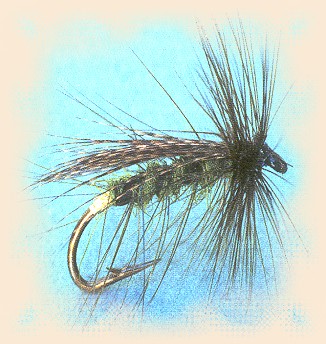Like Bill Nation, the demigod of interior lake fly
fishers, Tom Brayshaw, amongst many other talents,
was an observer of nature and a master fly dresser.
This is a necessary combination if one is to produce
flies representative of specific insects that work.
Brayshaw produced numerous sedge patterns and he fished
the interior lakes in the golden years - the 1920s and
1930s, when fish of 8 to 10 pounds and larger abounded
and came to a properly presented dry fly.
A Knouff Lake [British Columbia, Canada] fly fisher,
Brayshaw would often lend a helping hand to anglers he
met on the lake. Typical of his generosity and its
result was shown when, on July 3, 1932, after examining
the fly box of an aspiring Vancouver anglers, "who had
no suitable flies," Brayshaw gave him one of his Olive
Sedges and "he later got a 3 1/2 lb. fish on it, the
only one he got."
Knouff Lake fishermen such as Tom Brayshaw and Bryan
Williams produced numerous dry fly patterns to catch
Knouff's large trout. Typical of Brayshaw's sedges
is the palmered hackle, the first that I have come
across for British Columbian developed dry flies.
One of British Columbia's largest stillwater dry-fly
caught trout, and 17 1/4 pound monster, on a dry sedge,
came from Knouff Lake. There is some confusion, however,
about the date of this feat: Steve Raymond in Kamloops
(1971) records the year as 1930, Haig-Brown in
The Western Angler (1939) gives 1930 in
his text, but the accompanying photograph shows E.L. Hodgson
holding the fish, and the caption states 1932. The day this
great event occurred, June 12, 1932, four Hodgsons were at
the lake but Brayshaw too was there. About the Sunday
afternoon fishing Brayshaw had this to say:
Later I got one of 2 pounds 7 ounces on a dry sedge and
had quite a few rises. Mrs. P[hillips] lost a big one
(10 pounds or more) on Pazooka . . .After lunch I tried
Pazooka in almost flat calm and had a fish on at once
but lost it after a few jumps. At a quarter to 2 Eldred
[Hodgson] had come to Cape Horn . . .Just as the breeze
died away he hooked a big one which showed several time
and jumped quite a bit. I got up anchor to take him
a gaff and stand by. Ten minutes later I netted it
- a female 17 1/4 pounds 34 1/4" long and 19" in girth.
Slight rainbow stripe.
We do know that this fish took a dry fly and, reference
to the capture of this 17 1/4 pounder is given in the
text of William's Grey-Bodies Sedge found later in this
volume. Because Brayshaw was there that day and fishing
dry fly with his own sedge patterns and documented the
event, I believe this is an appropriate place to record
this piece of British Columbia's fly fishing history.
Recipe Olive Sedge
Hook: Number 8 or 9.
Tag: Flat, gold tinsel.
Body: Dark olive-green seal's fur.
Rib: Black floss.
Body Hackle: An olive hackle feather.
Wing: Bronze mallard.
Hackle: An olive hackle feather.
Originator: Tom Brayshaw.
Intended Use: Dry fly for rainbow trout.
Location: Knouff Lake [British Columbia].
Credit: From Fly Patterns of British Columbia,
by Arthur James Lingren, published by Frank Amato Publications. We
thank them for use permission.
|



